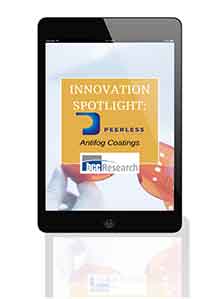Innovation Spotlight: Peerless Plastics & Coatings: Antifog Coatings
Whether heating the car on a freezing day, wearing a mask and sunglasses or having a hot shower, we all have experience with fogs. There is a range of fog-clearing solutions, from low-tech—drying up the fog with micro-fabrics, or, in a pinch, a sleeve, to high-tech—such as surfactants, which minimize the surface tension of the water; hydrophilic coatings, which maximize the surface energy; nanoparticles/hydrophilic colloids; and titanium oxide-based products.
Antifog coatings are chemical compounds that are essential for preventing water condensation on the surface of materials. These coatings, also known as non-mist coatings, help dissolve tiny droplets of fog that grow due to water condensation. Antifog coatings are translucent, abrasion-resistant and long-lasting so they don't degrade even after a lot of use. The building & manufacturing, automobile, aircraft & aerospace, communications, military & defense and medical & safety industries all use antifog coatings. They're used in military gas masks, garage forecourt gauge covers and fireman's visors. Antifog coatings are highly safe and are often used in waterproof sunglasses and sporting eyewear since they are long-lasting even after extended exposure to water vapor. Cameras, clocks, TV sets, medical electronic displays, traffic signal glass, curtains, side mirrors and industrial freezers are among the other applications.
To shed more light on the antifog coating process/applications, we scored an interview with Managing Director at Peerless Plastics and Coatings, Peter Llewellyn-Stamp. Peerless Plastics and Coatings is a frontier in offering a complete chain solution from design, research & development, supply and full production processes. Their success secret is their ability to tailor their processes to individual company and market requirements.
Download Innovation Spotlight
